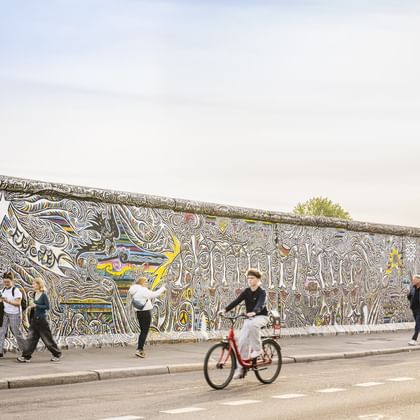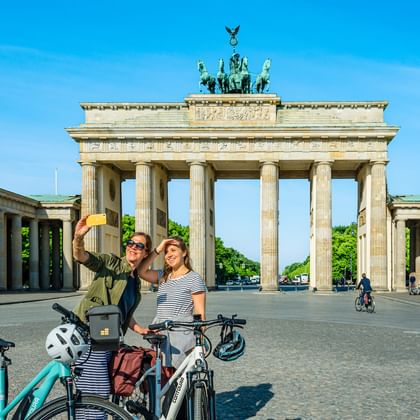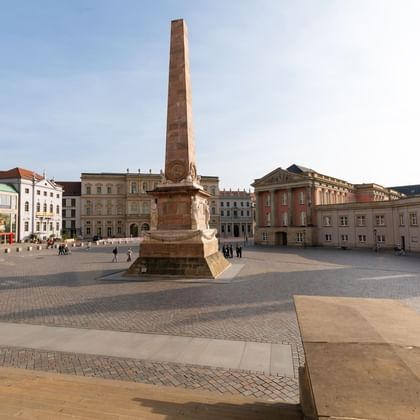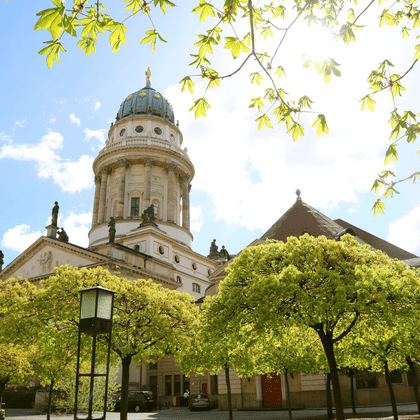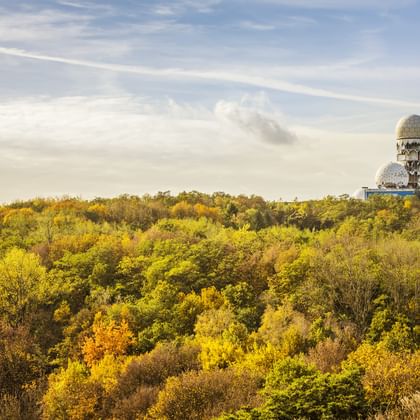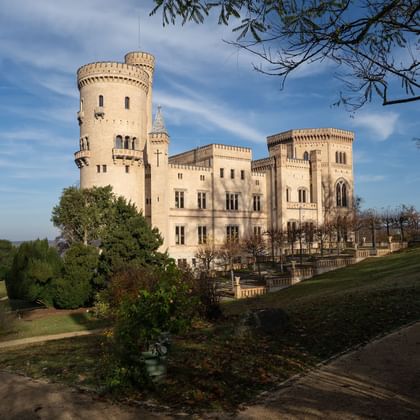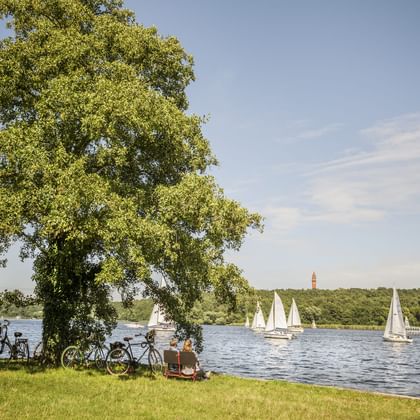Tour
Arrive on time, it will be worth it! You will get to know one of Germany’s most impressive towns. Visit the palace of Sanssouci with its wide park to marvel at Frederick the Great’s summer residence and do not miss out on the historical parts of Potsdam like the russian colony Alexandrowka, the dutch quarter and the former bohemian webber’s district. The famous film park Babelsberg, the leisure cruisers of Potsdam and the many parks only wait for you to come visit.
Another highlight awaits you only after a short while as the Glienicke bridge guides your way out of town. Built more than 300 years ago, the bridge came to attract world wide attention within only a few days as it became the legendary scene of the Cold War as the United States and the Soviet Union exchanged spies here. Today, the bridge unites Potsdam and the federal capital of Berlin again. Past Cecilienhof castle, where the Potsdam Conference was held in the summer of 1945 to decide over Germany’s partition into occupation zones, you will cycle to the Wannsee in Sacrow. Just by the Groß-Glienicke lake, you will encounter an original piece of the Berlin Wall before entering Spandau with Fort Hahnenberg, built in 1888 to protect the armament storage that Spandau was at the time. After 1952, Spandau was situated in the border area to become a kind of sleeping beauty in 1961. Apart from the occasional visits of the border guards, things stayed calm around here and nature took this chance to conquer the fortification back. Spandau and its small old town with the citadel are definitely worth a visit.
In the morning you cycle through the Spandauer Forst, formerly a restricted area in the GDR, whose mixed forest impresses with its biodiversity and which was declared a "nature reserve of European importance" in 2000. Look forward to the beautiful bike route along the almost overgrown Nieder-Neuendorfer Canal. It is worth taking a detour to the thousand-year-old oaks. Marvel at these giants: 7 oaks, 25 m high with a circumference of 3.87 m to 6.15 m. You cycle past Laßzinsee, a small Eldorado for water and marsh birds, to the banks of the Havel, in the middle of which the former border ran. Take a break at the former Nieder Neuendorf border tower (built in 1987), which has been restored and is a building under monument protection. Today it houses a small museum about the division of Germany and the border fortifications. During the GDR era, it served to monitor this section of the border and was also the command post for 18 other border watchtowers. On the 4 floors there were some utility rooms, a detention cell, the lounge for the border guards and the command post, in which at least two border guards always had to keep watch. The last few kilometers along the Stolper Heide are now quickly cycled, so that you can relax and end a beautiful day in Hohen Neuendorf.
On the Wall bike path you cycle through the Tegeler Fließ nature reserve, where you can gain an insight into a quaint swampy landscape. It is worth taking a detour to Lübars with its well-preserved village center and the old village church. Lübars is the only surviving village in the Berlin urban area and is still used for agriculture today, mainly for keeping horses. Along the disused railroad tracks of the Heidekrautbahn and past the Märkisches Viertel, a high-rise estate built between 1963 and 1974 in the immediate vicinity of the Berlin Wall, you cycle towards Berlin Mitte. It is now happening in rapid succession: You discover the Börsebrücke and Bornholmer Strasse, known as the place where the border was first opened on November 9th, 1989. You pass the Bernauer Strasse memorial, where on August 13, 1961 refugees tried to escape from the windows of the houses on the border strip, because the sidewalk was already West Berlin ground and the "Invalidenfriedhof" - a graveyard which was divided by the wall. You will also be impressed by the new Berlin Central Station and the parliament and government district. Hardly in the saddle you can already reach the Brandenburg Gate, the splendid Berlin boulevard "Unter den Linden" and Potsdamer Platz, which was no man's land in GDR times. You spend the night in the center of Berlin and can still use the evening to enjoy the Berlin nightlife.
Past the fomer Stasi-headquarters your bike takes you to Checkpoint Charlie, which between 1961 and 1990 used to be one of the most well-known border checkpoints of Berlin. On Friedrichstraße, it used to interconnect the Soviet sector with the US-sector, thus the town district “Mitte” of East Berlin with the town district “Kreuzberg” of West Berlin. The control point was only open to associates of the allied forces and embassies, foreign citizens, collaborates of the permanent representation of the Federal Republic of Germany and the GDR-officials. It often became the scene of spectacular escapes. Today, Checkpoint Charlie is a memorial site and one of Berlin’s most famous sights. Now, the Spree river with the East Side Gallery are the next stage of your route. Here, by Mühlenstraße, you will get to visit the largest preserved piece of the Berlin Wall on the town’s grounds. In 1990, artists from all over the world painted these last remaining 1,3 kilometres of the Berlin Wall.
Across the most beautiful bridge of Berlin, the Oberbaumbrücke dating from the 18th century, your bike takes you to the Landwehrkanal and across the trench Heidekampgraben to the Teltow channel in the town districts of Neukölln and Schönefeld. Would you like to experience Berlin by night once again? The close metro stations allow you to get back to the town centre in only 30 minutes.
Today, the Berlin Wall bike trail goes zigzagways along the southern edge of the town. You will discover Gropiusstadt, a residential estate of apartment towers and constructed blocks, housing up to 50.000 persons. In Marienfelde, an assembly and transit point helped more than 1,3 million refugees from the GDR to access the western German states until 1990. Today a memorial site and a museum have been erected in this place. You will now encounter a real ghost town: On 110 hectars of military restricted area, the US-army was trained for armed urban warfare.Then you will follow the beautiful Teltow channel and the Königsweg-trail to the former checkpoint Dreilinden. The control building, the roadhouse, the gas station and the terminal ramp for trucks are under monument protection today. Finally, the shore of the Griebnitzsee takes you back to Potsdam.
Today after breakfast your eventful bike tour ends on the traces of the young German history and on the Wall Cycle Path around Berlin.
Map
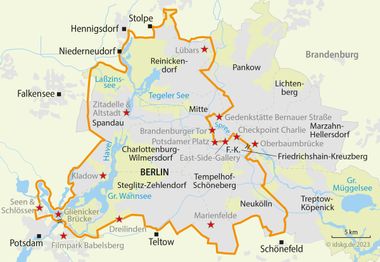
Prices / Dates
Services / Info
- Accommodation incl. breakfast: Comfortable middle-class hotels or smaller, family-run inns and hotels
- Room with shower/bath/WC
- Luggage transport
- Digital route guidance via smartphone app
- Tips for tour preparation
- Touristic information
- 7 days hotline service
Worth knowing about the bike tour Berlin: Wall Bike Trail
Below you will find specific and helpful information. If you have further questions about this trip, please simply call us: Phone: +49 (0) 6421 - 886890.
Arrival by train
Potsdam is easily accessible by train from all major cities in Germany. Our partner hotels are all within walking distance (5 - 10 minutes) from the next railway station. Current schedule information and price information can be found at www.bahn.de
Parking facilities at the arrival location
Our partner hotels in Potsdam offer parking facilities for the entire duration of your cycle tour. The costs are approx. 24.00 € per day, payable on site. A reservation is not possible. Detailed information on parking at your hotel, you will receive together with the detailed travel documents two weeks prior to departure
Condition of cycle paths
During your tour "on new bike trails around Berlin" you cycle on a variety of different bike paths and small side streets. The selected cycle routes have been created or paved within the last years and therefore of the highest quality. But there are also short passages of dirt road, sand or copplestone. The route is mostly flat. On day 4 and day 5 in the "Schorfheide" and the "Märkischen Schweiz" there are some hilly sections. The selected trails are well signposted and the route is signposted throughout with additional Velociped stickers (white V on green background).
Extra costs which are not included in the travel price
Any tourist tax and charging fees for bicycle batteries are not included in the tour price and must therefore be paid at the hotel.
7 days hotline service
In case of chain breakdown, flooding or other bad surprises that makes a continuation of your tour impossible: no problem, we also work during weekends and you can reach us 7 days a week in case of emergency.
Passport and visa requirements
For EU citizens, there are no special passport or visa requirements and no health formalities to be considered for this trip.
Travel insurance
The tour price already includes the statutory insolvency insurance. In addition, we recommend that you take out travel cancellation insurance upon receipt of your travel confirmation in order to protect yourself against financial disadvantages in the event of travel cancellation, interruption of travel, illness or accident.
For this trip, we recommend using digital travel documents in the interest of sustainability. However, if you prefer, you can choose printed travel documents with a cycling map during the booking process.
Please note that price differences may apply depending on your selection.
Individual travellers are also very welcome - we will be happy to make you an individual offer.
Available rental bikes
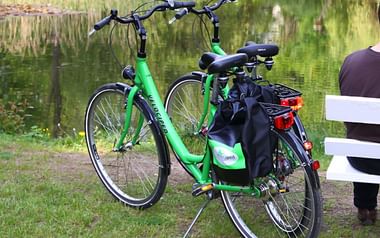
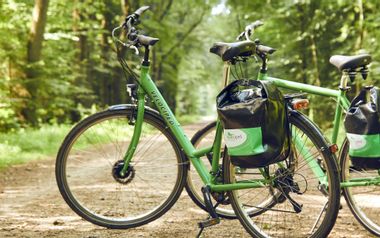
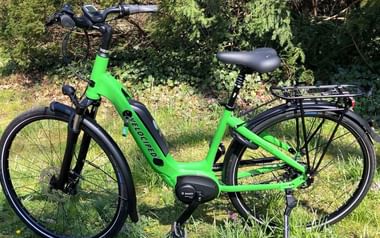

We would recommend the 7-speed tourer for all those that are looking for a back-pedal brake and wide gel seat for maximum comfort in an upright sitting position. It is equipped with a simple hub gear shift and is perfectly suited to tours on flat to slightly hilly terrain.

The 27-speed tourer is the best choice for cyclists that value the advantages of the dérailleur gear shift for flexibility whilst going up and down hills. This bike allows you to be a little more active without compromising on saddle comfort and practical everyday suitability.

E-bikes combine a lot of advantages. The electric drive ensures a completely relaxed cycling, even during long tours or on hilly routes. Other features, such as a suspension seat post and front fork plus well-tuned gears, ensure additional riding comfort.

I provide you with advice and assistance
Siri Nuphim
